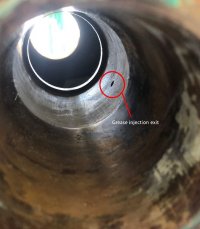Here is my recent analysis of the same issue, complete with homemade drawing and factory diagram
Summary: I studied my rudder mechanism and made a section drawing for future reference, included below. It seems important to have an abundance of grease squirted into the post sleeve. My rudder is currently out of my boat and I thought this...

ericsonyachts.org
Your boat is older so may be different. If you have an existing zerk, I would try to match the height. Otherwise I would try to go 6-8" below the top of your rudder stuffing box.
When you drill into the rudder log, probe gently as you push the bit in. You don't want to mar the rudder post and if the pressure splatters fiberglass thread shards into the center of the log, they may interfere with grease distribution and or create an annoying chafe for the rudder.
I also recommend you buy your zerk fitting first so that you can drill an appropriate hole that will sort-of create a tighten-able hole into which you can screw the zerk. I used some JB weld to help glue in the threaded zerk. I got these stainless ones on Amazon.
Utah Pneumatic 1/8" npt Stainless Steel Grease Fittings Assortment 4pcs-Straight, 4pcs-90-Degree, Elbow Grease 4pcs 45-Degree Angled Zerks Fittings Hydraulic Grease Nippel Kit(Pack of 12): Amazon.com: Industrial & Scientific
www.amazon.com
I have yet do do a full write-up or testing of my install, but there you go.

![Zerk[1].png Zerk[1].png](https://ericsonyachts.org/ie/data/attachments/29/29084-474635aab3e6c58a63e329d0a3b69a26.jpg)

